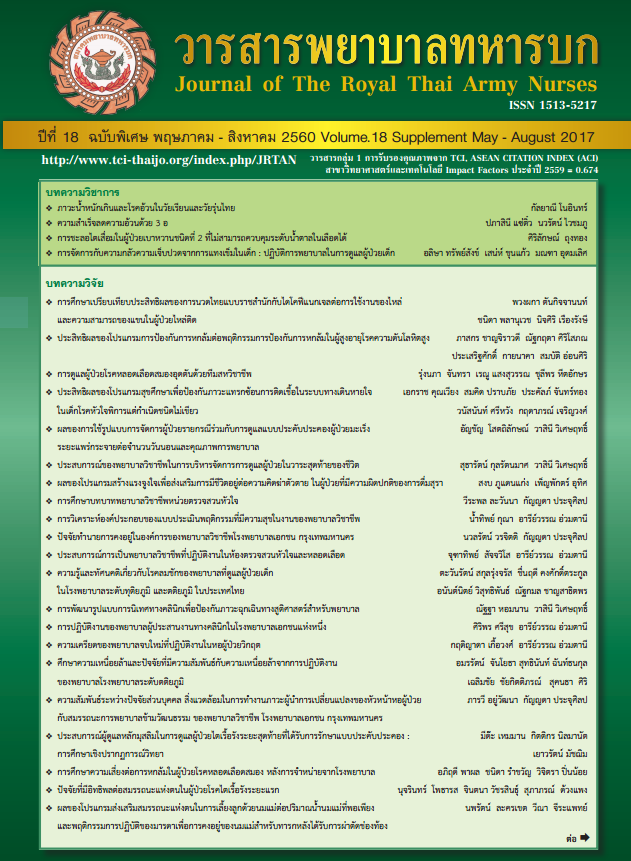การชะลอไตเสื่อมในผู้ป่วยเบาหวานชนิดที่ 2 ที่ไม่สามารถควบคุมระดับน้ำตาลในเลือดได้
Keywords:
ชะลอไตเสื่อมในผู้ป่วยเบาหวาน, เบาหวานชนิดที่ 2 ที่ไม่สามารถควบคุมระดับน้ำตาลในเลือดได้, Delayed progression diabetic nephropathy, Uncontrolled type 2 diabetes mellitusAbstract
โรคเบาหวานจัดเป็นโรคเรื้อรังซึ่งต้องการการดูแลอย่างต่อเนื่อง เป้าหมายในการดูแลเบาหวานคือการควบคุมระดับน้ำตาลในเลือดเพื่อป้องกันภาวะแทรกซ้อน ซึ่งหากไม่สามารถควบคุมระดับน้ำในเลือดได้ ภาวะไตเสื่อมจากเบาหวานจะเป็นภาวะแทรกซ้อนที่พบได้บ่อยที่สุด เบาหวานชนิดที่ 2 ที่ไม่สามารถควบคุมระดับน้ำตาลในเลือด วินิจฉัยโดยการตรวจพบค่าฮีโมโกลบินเอวันซีมากกว่า7 เปอร์เซ็นต์ หรือมีระดับน้ำตาลในเลือดหลังอดอาหาร 8 ชั่วโมงมากกว่า 130 มิลลิกรัมเดซิลิตร มีค่าความดันโลหิตที่มากกว่า130/80 มิลลิเมตรปรอทและ มาตรวจรักษาตามแพทย์นัดอย่างต่อเนื่องอย่างน้อย 12 เดือนสำหรับปัจจัยที่เกี่ยวข้องกับการเสื่อมของไตนอกจากการไม่สามารถควบคุมระดับน้ำตาลในเลือดได้ การมีโรคร่วม เช่น โรคความดันโลหิตสูงและไขมันในเลือดสูง พฤติกรรมการรับประทานอาหารที่มีโปรตีนสูง อาหารที่มีรสเค็มจัด พฤติกรรมการใช้ยาในผู้ป่วยโรคเรื้อรัง ก็เป็นปัจจัยส่งเสริมให้เกิดภาวะไตเสื่อมได้เร็วกว่าปกติ แนวทางการชะลอไตเสื่อมในผู้ป่วยเบาหวานที่ไม่สามารถควบคุมระดับน้ำตาลในเลือดได้โดยเริ่มต้นจากในแต่ละปีให้ตรวจประเมินโปรตีนอัลบูมินในปัสสาวะและอัตราการกรองของไต ควบคุมระดับน้ำตาลในเลือดให้ได้ตามเป้าหมาย และโรคร่วมที่เกิดขึ้นโดยเฉพาะระดับความดันโลหิต ซึ่งยาที่เหมาะสำหรับการควบคุมความดันในผู้ป่วยที่มีภาวะไตเสื่อมจากเบาหวานได้แก่ ยาในกลุ่ม ACE หรือ ARBs การควบคุมอาหารประเภทโปรตีน ปริมาณต่อวันที่ผู้ป่วยสามารถรับได้ไม่เกิน 0.8 กรัมต่อน้ำหนักตัวหนึ่งกิโลกรัม (1 ช้อนโต๊ะ) หลีกเลี่ยงยาหรือสารพิษที่ทำลายไต เช่น ยาแก้ปวด แก้อักเสบ (บางตัว) ยาชุดแก้ปวด และสมุนไพร และที่สำคัญคือ การได้รับการสนับสนุนการจัดการตนเองจากสังคมรอบข้าง ทั้งครอบครัวและหน่วยงานสาธารณสุข ซึ่งปัจจัยดังกล่าวข้างต้น หากผู้ป่วยเบาหวานชนิดที่ 2 สามารถควบคุมได้สำเร็จ จะสามารถช่วยชะลอการเสื่อมของไตให้ช้าลง
Delayed Progression Diabetic Nephropathy in Patients with Uncontrolled Type 2 Diabetes Mellitus
Diabetes is a chronic disease that requires constant care. The goal in diabetes care is to control blood sugar levels to prevent complications. Diabetic kidney disease is one of the most common complications. Uncontrolled type 2 diabetes mellitus is diagnosed by detecting more than 7 percent of HbA1c or having a blood sugar of more than 130 mg/dl after fasting for 8 hours, the blood pressure is higher than 130/80 mm Hg, and the patient has been treated continuously for at least 12 months. Factors related to Diabetic Nephropathy are associated diseases, such as hypertension and hypercholesterolemia; self-care behaviors, which are eating high protein and salty foods; and chronic drug use behavior. These are factors that promote kidney failure faster. There are methods to delay the progress of kidney failure in patients with uncontrolled diabetes mellitus. First, assessment of the patients’ urinary albumin and estimated glomerular filtration rate at least once a year. Also, control blood sugar and common diseases according to the goal setting, especially blood pressure. Drug for blood pressure management in patients with diabetic nephropathy are medications in ACE or ARBs. Dietary protein intake should be approximately 0.8 g/kg body weight per day (1 spoon). Lastly, avoidance of drugs or toxins that damage the kidneys, for example some anti-inflammatory drugs and herbs. The key for successful control are social support and self-management of patients. If the patient’s uncontrolled type 2 diabetes mellitus can be controlled successfully, it can delay the progression of diabetic nephropathy
Downloads
Downloads
How to Cite
Issue
Section
License
บทความหรือข้อคิดเห็นใดใดที่ปรากฏในวารสารพยาบาลทหารบกเป็นวรรณกรรมของผู้เขียน ซึ่งบรรณาธิการหรือสมาคมพยาบาลทหารบก ไม่จำเป็นต้องเห็นด้วย
บทความที่ได้รับการตีพิมพ์เป็นลิขสิทธิ์ของวารสารพยาบาลทหารบก
The ideas and opinions expressed in the Journal of The Royal Thai Army Nurses are those of the authors and not necessarily those
of the editor or Royal Thai Army Nurses Association.






